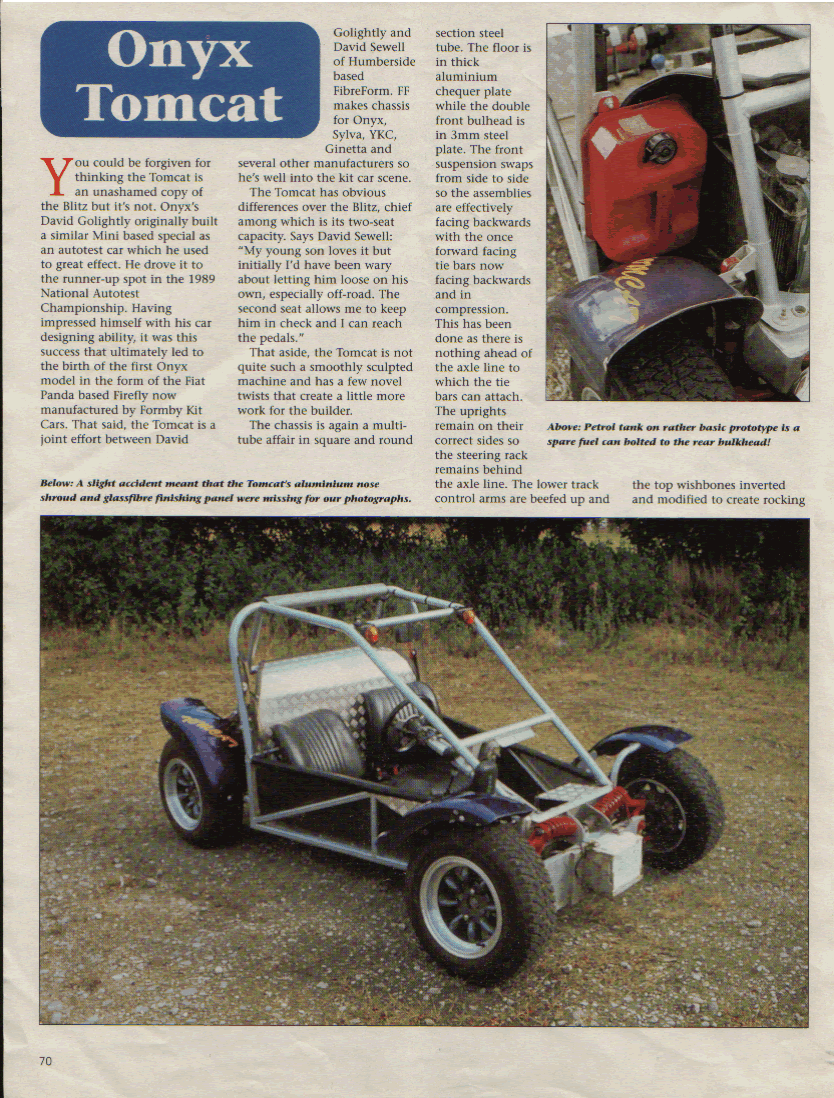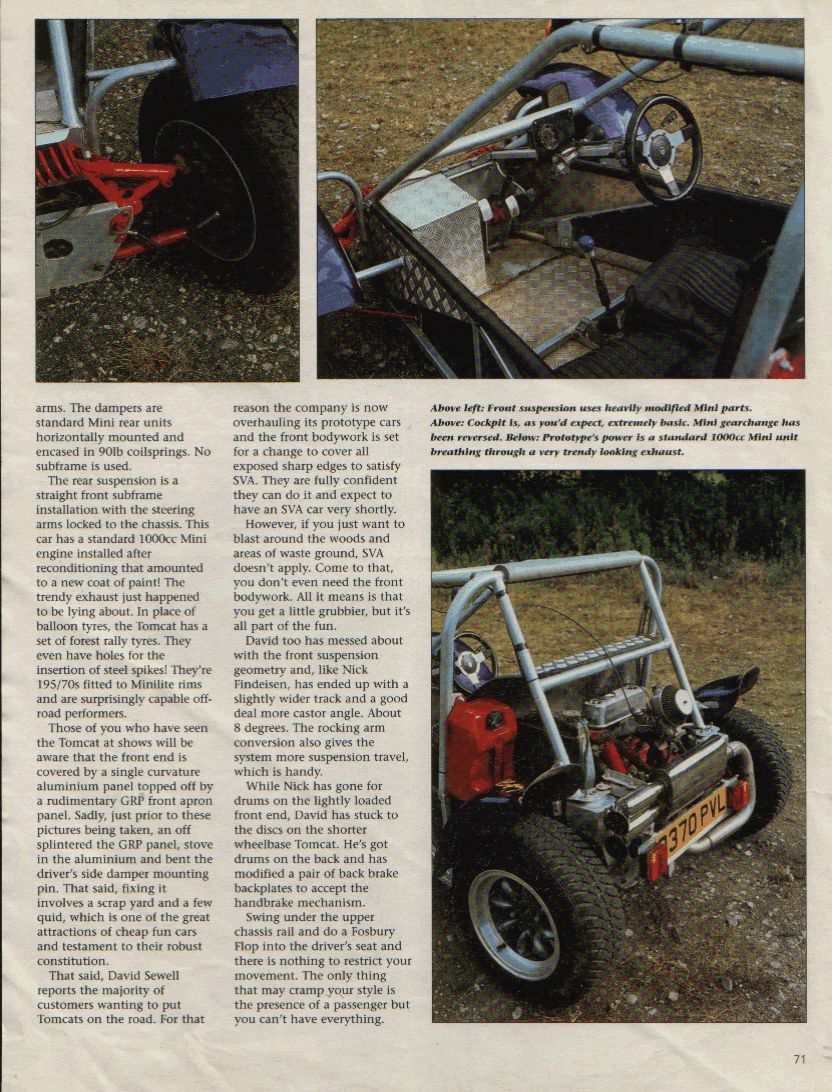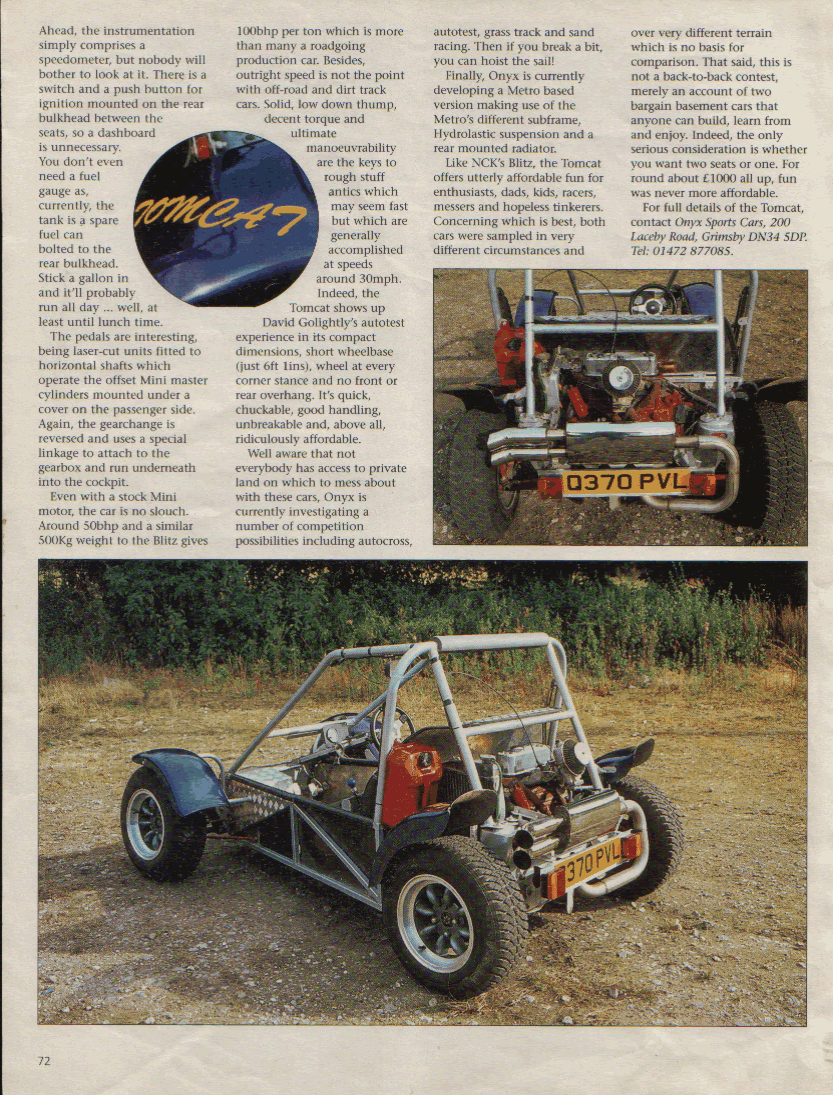You could be forgiven for thinking the Tomcat is an unashamed copy of the Blitz but its not. Onyx’s David Golightly originally built a similar Mini based special as an autotest car which he used to great effect. he drove it in the runner up spot in 1989 National Auto Test Championship. Having impressed himself with his car designing ability, it was this success that ultimately led to the birth of the first Onyx model in the form of the Fiat Panda based firefly now manufactured by Formby Kit Cars. That said, the Tomcat is a joint effort between David Golightly and David Sewell of humberside based fibreform. FF makes chassis for Onyx Sylva, YKC Ginetta and several other manufacturers so he’s well into the kit car scene.
The Tomcat has obvious differences over the Blitz, chief among which is its two seat capacity. says David Sewell: “My young son loves it but initially I’d have been wary of letting him loose on his own especially off-road. The second seat allows me to keep him in check and I can reach the pedals.”
That aside, The Tomcat is not quite such a smoothly sculpted machine and has a few novel twists that create a little more work for the builder.
The chassis is again is a multi tube affair in square and round section steel tube. The floor is in thick aluminium chequer plate while the double front bulkhead is in 3mm steel plate.. The front suspension swaps from side to side so the assemblies are effectively facing backwards with the once forward facing tie bars now facing backwards and in compression.
This has been done as there is nothing ahead of the axel line which to which the tie bars can attach. The uprights remain on their correct sides so the steering rack remains behind the axel line. The lower track control arms are beefed up and the top wishbones inverted and modified to create rocking arms. The dampers are standard mini rear units horizontally mounted and encased in 90lb coilsprings. No subframe is used.
The rear suspension is a straight front subframe installation with the steering arms locked to the chassis. This car has standard 1000cc Mini engine installed after reconditioning that amounted to a new coat of paint! The trendy exhaust happened to be lying about. In place of balloon tyres, the tomcat has a set of forest rally tyres. They even have holes for the insertion of steel spikes! They’re 195/70s fitted to Minilite rims and are surprisingly capable offroad performers.
Those of you who have seen the tomcat at shows will be aware that the front end is covered by a single curvature aluminium panel topped off by a rudimentary GRP front apron panel. Sadly, just prior to these pictures being taken, an off splintered the GRP panel, stove in the aluminium and bent the drivers side damper mounting pin. That said, fixing it involves a scrap yard and a few quid, which is one of the great attractions of cheap fun cars and testament to their robust constitution.
That said, David sewell reports the majority of customers wanting to put Tomcats on the road. For that reason the company is now overhauling its prototype cars and the front bodywork is set for a change to cover all exposed sharp edges to satisfy SVA. They are fully confident they can do it and expect to have an SVA car very shortly.
However, if you just want to blast around the woods and areas of waste ground, SVA doesn’t apply. Come to that, you dont even need the front bodywork. All it means is that you get a little grubbier, but its all part of the fun.
David too has messed about with the front suspension geometry and, like nick Findeisen, has ended up with a slightly wider track with a good deal more castor angle. About 8 degrees. The rocking arm conversion also gives the system more suspension travel, which is handy.
Whiel Nick has gone for drums on the lightly loaded front end, David has stuck to discs on the shorter wheelbase Tomcat. He’s Got drums on the back and has modified a pair of back brake backplates to accept the handbrake mechanism.
Swing under the upper chassis rail and do a Fosby Flop into the driver’s seat and there is nothing to restrict your movement. The only thing that may cramp your style is the presence of a passenger but you can’t have everything.
Ahead, the instrumentation simply comprises a speedometer, but nobody will bother to look at it. There is a switch and a push button for ignition mounted on the rear bulkhead between the seats, so a dashboard is unnecessary. You dont even need a fuel gauge as currently, the tank is a spare fuel can bolted to the rear bulkhead. STick a gallon in and it’ll probably run all day … well, at least till lunch time.
The pedals are interesting, being laser cut units fitted to horizontal shafts which operate the offset Mini master cylinders mounted under a cover on the passenger side. Again, the gearchange is reversed and uses a special linkage to attach to the gearbox and run underneath into the cockpit.
Even with a stock Mini motor, the car is no slouch. Around 50bhp and a similiar 500kg weight to the Blitz gives 100bhp per ton which is more than many a road going production car. Besides outright speed is not the point with offroad and dirt track cars. Solid, low down thump, decent torque and ultimate maneuverability are the keys to rough stuff antics which may seem fast but which are generally accomplished at speeds around 30mph. Indeed, the Tomcat shows up David Golightly’s autotest experience in its compact dimensions, short wheelbase (just 6ft 1ins), wheel at every corner stance and no front or rear overhang. It’s quick, chuckable, good handling, unbreakable and above all rediculously affordable.
Well aware that not everybody has access to private land on which to mess about with these cars, Onyx is currently investigating a number of competition possibilities including autocross, autotest, grass track and sand racing. Then if you break a bit, you can hoist the sail!
Finally, Onyx is currently developing a metro based version making use of the Metro’s differnt subframe, hydrolastic supension and a rear mounted radiator.
Like NCK’s Blirz, the Tomcat offers utterly affordable fun for enthusiasts, dads, kids, racers, messers and hopeless tinkerers. Concerning which is best , both cars were sampled in very different circumstances and over very different terrain which is no basis for comparison. That said, this is not a back to back contest, merely an account of two bargain basement cars that anyone can build, learn from and enjoy. Indeed, the only serious consideration is whether you want two seats or one, for about £100 all up, fun was never more affordable.




